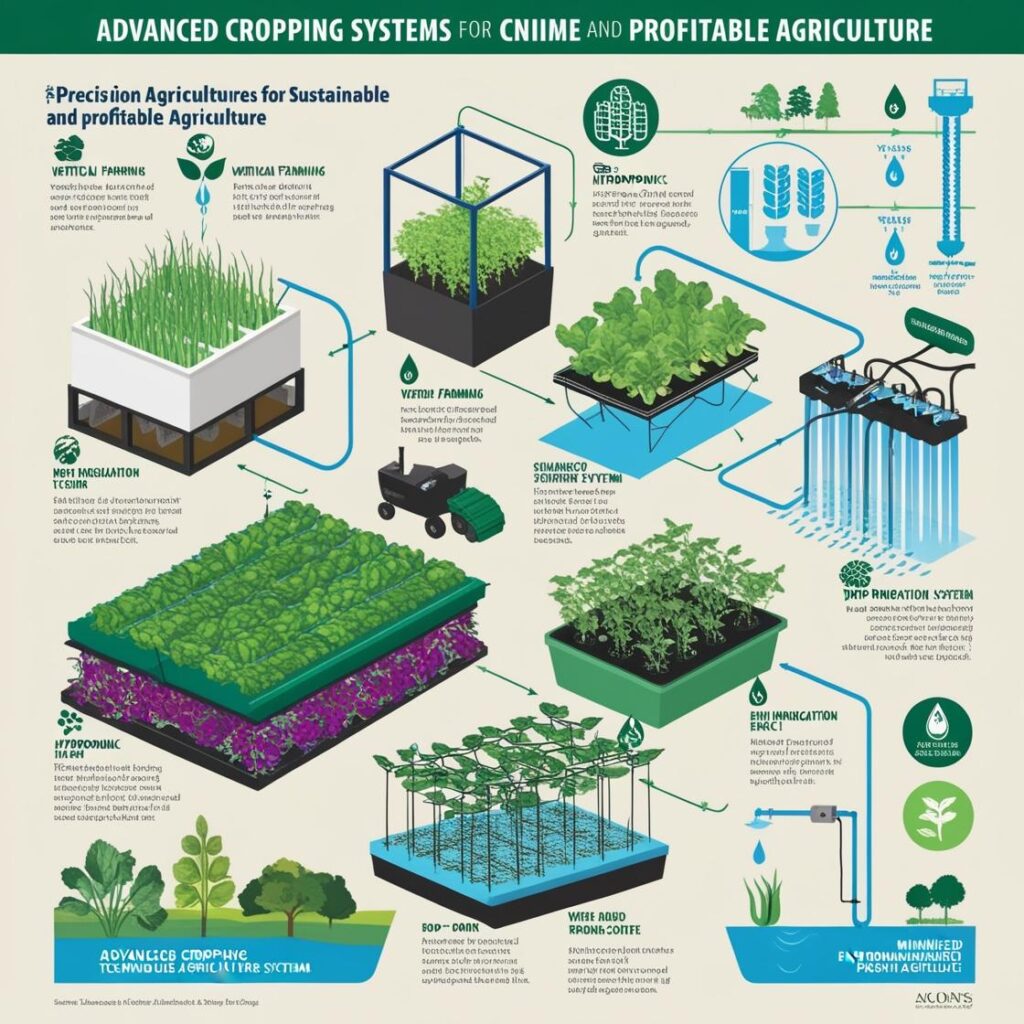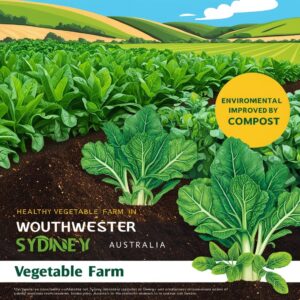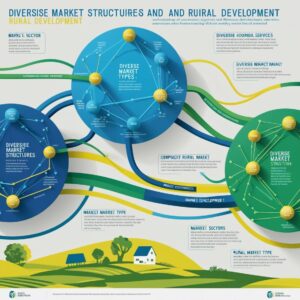
Agriculture, at its heart, is about getting the most out of every square inch of land, every drop of water, and every hour of sunlight. But achieving this while maintaining soil health, conserving resources, and protecting crops from pests and climate impacts is no small feat. Today, I’ll dive into a range of cropping systems that aim to do just this, enhancing both productivity and sustainability.
Why Efficiency Matters in Agriculture
Efficient cropping systems are designed to maximize every resource—be it soil nutrients, water, or labor. Yet, with intensified cultivation, challenges like soil depletion, pest resistance, and declining groundwater levels have cropped up, especially in cereal-dominated systems. The good news? Researchers have developed targeted cropping systems to address these very issues. Let’s unpack these techniques.
1. Intensive Cropping for Resource Utilization
- When space is limited, intensive cropping systems—double, triple, or even quadruple cropping—are a powerful way to make full use of land, water, and labor.
- Tip: Include vegetables in areas where labor is abundant or use capital-intensive crops like sugarcane if capital resources allow. If dairy is part of the farm, adding fodder crops is wise.
2. Legumes for Nutrient Efficiency
- Incorporating legumes like groundnut or cowpea into crop rotations isn’t just beneficial—it’s essential. These nitrogen-fixing plants naturally enrich the soil, improving its structure and boosting microbial activity, creating a solid foundation for subsequent crops.
- Actionable Insight: Try rotating legumes with sorghum or maize; studies show these can reduce the nitrogen needed for follow-up cereal crops by up to 60 kg/ha!
3. Intercropping to Manage Weeds and Pests
- Strategically interchanging crops can control stubborn weeds and reduce the need for herbicides. For example, rotating cotton with maize helps suppress the notorious Johnson grass.
- Practical Tip: Choose shade-producing crops like berseem as break crops to suppress weeds naturally. For pest control, pairing crops like pigeon pea with sorghum has been shown to lower pest impact while boosting yields.
4. Water-Efficient Crop Rotations
- Given the cost and scarcity of water, finding crop rotations that maximize water efficiency is essential. From rice-mustard-greengram to rice-potato systems, researchers have found combinations that deliver high returns without excess water.
- Water-Wise Tip: Consider crop rotations like rice-lentil in high irrigation areas or soybean-wheat under low irrigation for optimal water use.
5. Climate-Adapted Cropping Systems
- With climate change impacting everything from pest cycles to water availability, switching to resilient crops can stabilize yields. Systems like maize-wheat or direct-seeded rice-wheat use fewer resources and adapt well to temperature fluctuations.
- Proactive Advice: Try adjusting planting dates to avoid peak summer heat and protect yields from temperature-induced sterility in flowering plants.
6. Evaluating Efficiency: Key Indices
- To understand and compare cropping systems, various indices are used. From the Land Equivalent Ratio (LER) to Crop Intensity Index (CII), these measures help farmers optimize their rotations based on available resources.
- Did You Know? An LER greater than 1 indicates that intercropping yields more than sole cropping, highlighting the value of multiple crops grown together.
Summary for Social Media and Visuals
For quick tips on maximizing crop efficiency and productivity, here are some highlights perfect for Instagram Reels or infographics:
- Legume Power: Rotate legumes like groundnut or cowpea to naturally enrich nitrogen levels in your soil.
- Intensive Cropping: Go double, triple, or quadruple cropping to make the most of limited space.
- Weed Control without Chemicals: Use shade-producing crops like berseem as break crops to naturally curb weeds.
- Water Smart: Save water with rotations like rice-mustard or rice-lentil for high water-use efficiency.
- Climate-Resilient Choices: Opt for resilient crop systems like maize-wheat to handle climate impacts.
- Measure Success: Use LER and CII to assess how well your system uses resources.
Here’s a breakdown of the different intercropping indices:
- Relative Crowding Coefficient (RCC):
- Measures the dominance of one crop over another in intercropping.
- For two crops, aaa and bbb:
- For crop aaa: Kab=Yab×Zba(Yaa−Yab)×ZabK_{ab} = \frac{Y_{ab} \times Z_{ba}}{(Y_{aa} – Y_{ab}) \times Z_{ab}}Kab=(Yaa−Yab)×ZabYab×Zba
- For crop bbb: Kba=Yba×Zab(Ybb−Yba)×ZbaK_{ba} = \frac{Y_{ba} \times Z_{ab}}{(Y_{bb} – Y_{ba}) \times Z_{ba}}Kba=(Ybb−Yba)×ZbaYba×Zab
- If K>1K > 1K>1, it shows yield advantage (one crop is more competitive); if K=1K = 1K=1, no advantage; if K<1K < 1K<1, disadvantage.
- Aggressivity (Aab):
- Measures the difference in yield increase between two species.
- For crops aaa and bbb: Aab=YabYaa×Zab−YbaYbb×ZbaA_{ab} = \frac{Y_{ab}}{Y_{aa} \times Z_{ab}} – \frac{Y_{ba}}{Y_{bb} \times Z_{ba}}Aab=Yaa×ZabYab−Ybb×ZbaYba
- Positive values indicate dominance of crop aaa, negative values indicate dominance of crop bbb.
- Competitive Ratio (CR):
- Accounts for the difference in competitiveness between crops.
- For crops aaa and bbb: CRa=YabYaa×Zab÷YbaYbb×ZbaCR_{a} = \frac{Y_{ab}}{Y_{aa} \times Z_{ab}} \div \frac{Y_{ba}}{Y_{bb} \times Z_{ba}}CRa=Yaa×ZabYab÷Ybb×ZbaYba
- Adjusts for relative yields and seeding proportions, making it useful for interpreting competition.
- Competition Index (CI):
- Based on equivalent factors (i.e., yield/plant) of each crop.
- Equivalent factor for crop aaa: Equivalence Factor for ’a’=yield of ’b’/plantyield of ’a’/plant\text{Equivalence Factor for ‘a’} = \frac{\text{yield of ‘b’/plant}}{\text{yield of ‘a’/plant}}Equivalence Factor for ’a’=yield of ’a’/plantyield of ’b’/plant
- CI combines these factors for each component crop.
- Competition Coefficient (CC):
- Ratio of RCC for a given species to the total RCC, showing the relative crowding without harming yield.
- Area Time Equivalency Ratio (ATER):
- Evaluates area and time efficiency in intercropping.
- For two crops aaa and bbb: ATER=La×Da+Lb×DbTATER = \frac{L_a \times D_a + L_b \times D_b}{T}ATER=TLa×Da+Lb×Db where LaL_aLa and LbL_bLb are partial LERs, DaD_aDa and DbD_bDb are crop durations, and TTT is the total intercropping period.

About Us
Welcome to Agriculture Novel, your go-to source for in-depth information and insights into the world of agriculture, hydroponics, and sustainable farming. Our mission is to educate, inspire, and empower a new generation of farmers, hobbyists, and eco-conscious enthusiasts. Whether you’re interested in traditional farming practices or modern innovations, we aim to provide comprehensive guides, expert tips, and the latest updates in agriculture and urban farming.
At Agriculture Novel, we believe in the power of knowledge to transform the way we grow, sustain, and nourish our world. Explore our articles on topics like Fruit Growing Guide, Hydroponics, Plant Deficiency Guide, and more.
Thank you for joining us on this journey towards a greener, more sustainable future!
About Agronique Horizon
At Agronique Horizon, we specialize in delivering comprehensive digital marketing and web development solutions tailored for the agriculture and hydroponics industries. From custom website design and app development to social media management, we provide end-to-end support for brands aiming to make a meaningful impact. Our team also offers innovative solutions for the real estate sector, bringing precision and visibility to your projects. Learn more about our services here and discover how we can elevate your digital presence




